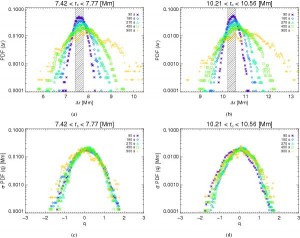
The dynamic properties of the quiet Sun photosphere can be investigated by analyzing the pair dispersion of small-scale magnetic fields (i.e., magnetic elements). By using 25 h-long Hinode magnetograms at high spatial resolution ( ), we tracked 68 490 magnetic element pairs within a supergranular cell near the disk center. The computed pair separation spectrum, calculated on the whole set of particle pairs independently of their initial separation, points out what is known as a super-diffusive regime with spectral index γ = 1.55 ± 0.05, in agreement with the most recent literature, but extended to unprecedented spatial and temporal scales (from granular to supergranular). Furthermore, for the first time, we investigated here the spectrum of the mean square displacement of pairs of magnetic elements, depending on their initial separation r0. We found that there is a typical initial distance above (below) which the pair separation is faster (slower) than the average. A possible physical interpretation of such a typical spatial scale is also provided.
), we tracked 68 490 magnetic element pairs within a supergranular cell near the disk center. The computed pair separation spectrum, calculated on the whole set of particle pairs independently of their initial separation, points out what is known as a super-diffusive regime with spectral index γ = 1.55 ± 0.05, in agreement with the most recent literature, but extended to unprecedented spatial and temporal scales (from granular to supergranular). Furthermore, for the first time, we investigated here the spectrum of the mean square displacement of pairs of magnetic elements, depending on their initial separation r0. We found that there is a typical initial distance above (below) which the pair separation is faster (slower) than the average. A possible physical interpretation of such a typical spatial scale is also provided.
more at: http://www.aanda.org/articles/aa/abs/2014/09/aa24380-14/aa24380-14.html




More Stories
Stage a Tor Vergata: Summer 2019
A night at the University.
ESCAPE Project Press Release